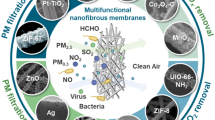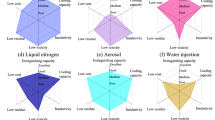Abstract
A new non-toxic, clean, and effective dry water (DW) nanomaterial is synthesized, and its extinguishing performance is characterized for pool fire. The nanomaterial reaches up to 93% water content due to its special core–shell structure. Phytic acid (PA) is used to functionalize DW to obtain DW/PA because of its biocompatibility and phosphorus-rich properties. The results of the Fourier transform infrared, X-ray photoelectron spectroscopy, thermal gravity analyzer, and optical microscope successfully verify the preparation of DW/PA samples. The DW/PA samples are cylindrical particles with a length of 100–200 μm and have excellent fluidity, with a repose angle of about 29°. The centrifugation and water loss rate tests indicate that the samples have appropriate mechanical stability and are suitable for storage in closed spaces. The extinguishing efficiency of DW/PA samples is characterized using a fire-extinguishing experiment designed by international standards. The average extinguishing time and consumption of DW/PA samples are reduced by 77.08% and 77.67%, respectively, comparing with commercial ABC dry powder-extinguishing agents. Moreover, fire-extinguishing efficiency is positively correlated with PA content. According to experimental results and established theories, the extinguishing mechanism of DW/PA samples is discussed and divided into three parts: chemical inhibition, the cooling effect, and the asphyxiation effect.
Graphical Abstract














Similar content being viewed by others
References
Xu W, Jiang Y, Qiu R (2017) Influence of halon replacements on laminar flame speeds and extinction limits of hydrocarbon flames. Combust Flame 182:1–13
Fleming JW, Sheinson RS (2007) Development of a cup burner apparatusfor fire suppression: evaluation of high-expansion foams. Fire Technol 48:615–623
Lu JZ, Chen BH, Fang Z (2018) Electrical safety of suppressing wildfires near high-voltage transmission lines using water mist. J Fire Sci 36:295–314
Jiang HR, Jiang Y, Zhu XL, Wang YC (2020) Investigation of aluminate coupling agent as modifier and its application on improving flame retardant of intumescent flame retardant coatings. Macromol Res 28(13):1211–1219
Zhi HQ, Bao YQ, Wang L, Mi YX (2020) Extinguishing performance of alcohol-resistant firefighting foams on polar flammable liquid fires. J Fire Sci 38:53–74
Fan RJ, Jiang Y, Jiang HR (2021) Experimental and theoretical investigation of dry-water containing phosphoric acid for new fire suppressant. J Loss Prevent Proc 70:104399
Saleh K, Forny L, Guigon P, Pezron I (2011) Dry water: from physico-chemical aspects to process-related parameters. Chem Eng Res Des 89:537–544
Yang J, Tan HY, Low QX, Binks BP, Chin JM (2015) CO2 capture by dry alkanolamines and an efficient microwave regeneration process. J Mater Chem 3(12):6440–6446
Sheng YJ, Xue MH, Ma L (2021) Environmentally friendly firefighting foams used to fight flammable liquid fire. Fire Technol 57:2079–2096
Forny L, Pezron I, Saleh K, Guigon P, Komunjer L (2007) Storing water in powder form by self-assembling hydrophobic silica nanoparticles. Powder Technol 171(1):15–24
Yi CF, Boluk Y, Bindiganavile V (2020) Enhancing alkali-activation of metakaolin-based geopolymers using dry water. J Clean Prod 258:120676
Ni XM, Zhang SG, Zheng Z, Wang XS (2018) Application of water@silica core-shell particles for suppressing gasoline pool fires. J Hazard Mater 341:20–27
Han Z, Pasman HJ, Mannan MS (2017) Extinguishing fires involving ammonium nitrate stock with water: possible complications. J Fire Sci 35:457–483
Cheng XW, Guan JP, Chen G, Yang XH, Tang RC (2016) Adsorption and flame retardant properties of bio-based phytic acid on wool fabric. Polymers 8:122
Liu XH, Zhang QY, Peng B, Ren YL, Cheng BW, Ding C, Su XW (2020) Flame retardant cellulosic fabrics via layer-by-layer self-assembly double coating with egg white protein and phytic acid. J Clean Prod 243:118641
Gao YY, Deng C, Du YY, Huang SC, Wang YZ (2019) A novel bio-based flame retardant for polypropylene from phytic acid. Polym Degrad Stabil 161:298–308
Cheng XW, Guan JP, Yang XH, Tang RC, Yao F (2019) A bio-resourced phytic acid/chitosan polyelectrolyte complex for the flame retardant treatment of wool fabric. J Clean Prod 223:342–349
Zhang ZH, Ma ZY, Leng Q, Wang YH (2019) Eco-friendly flame retardant coating deposited on cotton fabrics from bio-based chitosan, phytic acid and divalent metal ions. Int J Biol Macromol 140:303–310
Tehrani-Bagha AR (2016) Cationic gemini surfactant with cleavable spacer: emulsion stability. Colloids Surf 508:79–84
Santomaso A, Lazzaro P, Canu P (2003) Powder flowability and density ratios: the impact of granules packing. Chem Eng Sci 58(13):2857–2874
Wang X, Romero MQ, Zhang XQ, Wang R, Wang DY (2015) Intumescent multilayer hybrid coating for flame retardant cotton fabrics based on layer-by-layer assembly and sol-gel process. RSC Adv 5:10647–10655
Sim GY, Lee SU, Lee JW (2020) Enhanced extraction of phytic acid from rice hulls with enzymatic treatment and production of ethanol from reducing sugars in hydrolyzed rice hulls after extraction of phytic acid. LWT 133:110111
Carr RL (1965) Evaluating flow properties of solids. Chem Eng 72:163–168
Sheng YJ, Xue MH, Zhang SW (2020) Role of nanoparticles in the performance of foam stabilized by a mixture of hydrocarbon and fluorocarbon surfactants. Chem Eng Sci 31:115977
Ewing CT, Faith ER, Hughes JT, Carhart HW (1989) Evidence for flame extinguishment by thermal mechanisms. Fire Technol 25:195–212
Kuang K, Huang X, Liao G (2008) A comparison between superfine magnesium hydroxide powders and commercial dry powders on fire suppression effectiveness. Process Saf Environ 86(3):182–188
Jiang Z, Wang C, Fang S, Ji P, Wang H, Ji C (2018) Durable flame-retardant and antidroplet finishing of polyester fabrics with flexible polysiloxane and phytic acid through layer-by-layer assembly and sol-gel process. J Appl Polym Sci 135:46414
Cooper CE, Withers PC (2010) Effect of sampling regime on estimation of basal metabolic rate and standard evaporative water loss using flow-through respirometry. Physiol Biochem Zool 83(2):385–393
Liu XS, Zhou XC, Yang CZ, Huang J, Kuang F, Wang H (2020) Study on the effect of particle size and dispersion of SiO2 on tribological properties of nitrile rubber. Wear 460–461:203428
Meng N, Hu LH, Liu S (2012) Full-scale experimental study on fire suppression performance of a designed water mist system for rescue station of long railway tunnel. J Fire Sci 30:138–157
Babushok V, Tsang W (2000) Inhibitor rankings for alkane combustion. Combust Flame 123:488–506
Ananth R, Mowrey RC (2008) Ultra-fine water mist extinction dynamics of a co-flow diffusion flame. Combust Sci Technol 180:1659–1692
Charles JK, Douglas D (1994) Solid particulate aerosol fire suppressants. Fire Technol 30:387–399
Ananth R, Farley JP (2010) Suppression dynamics of a co-flow diffusion flame with high expansion aqueous foam. J Fire Sci 28:181–208
Du D, Shen X, Feng L, Hua M, Pan X (2019) Efficiency characterization of fire extinguishing compound superfine powder containing Mg(OH)2. J Loss Prevent Proc 57:73–80
Liu ZL, Shang SM, Chiu K, Jiang SX, Dai FY (2019) Fabrication of conductive and flame-retardant bifunctional cotton fabric by polymerizing pyrrole and doping phytic acid. Polym Degrad Stabil 167:277–282
Krasnyansky M (2008) Studies of fundamental physical-chemical mechanisms and processes of flame extinguishing by powder aerosols. Fire Mater 32:27–37
Ren X, Jiang Y, Xu W (2016) Numerical investigation of the chemical and physical effects of halogenated fire suppressants addition on methane-air mixtures. J Fire Sci 34:416–430
Simpson WR, Glasow RV, Riedel K, Anderson P, Ariya P (2007) Halogens and their role in polar boundary-layer ozone depletion. Eur Geosci Union 16:4375–4418
Acknowledgements
This work was supported by the National Natural Science of China (No. 51576183), the National Key R&D Program of China (No. 2016YFC0801505), and the Fundamental Research Funds for the Central Universities of China (No. WK2320000041).
Author information
Authors and Affiliations
Corresponding author
Ethics declarations
Competing interest
The authors declare that they have no known competing financial interests or personal relationships that could have appeared to influence the work reported in this paper.
Additional information
Publisher's Note
Springer Nature remains neutral with regard to jurisdictional claims in published maps and institutional affiliations.
Supplementary Information
Below is the link to the electronic supplementary material.
Supplementary file1 (MP4 12020 KB)
Supplementary file2 (MP4 10765 KB)
Supplementary file3 (MP4 12545 KB)
Supplementary file4 (MP4 14497 KB)
Supplementary file5 (MP4 14533 KB)
Supplementary file6 (MP4 12082 KB)
Supplementary file7 (MP4 13803 KB)
Rights and permissions
About this article
Cite this article
Jiang, H., Jiang, Y., Fan, R. et al. A Bio-resourced and Superhydrophobic Dry Water Extinguishing Agent for Pool Fire Based on Phytic Acid and Silicon. Fire Technol 60, 1203–1224 (2024). https://doi.org/10.1007/s10694-021-01192-0
Received:
Accepted:
Published:
Issue Date:
DOI: https://doi.org/10.1007/s10694-021-01192-0




